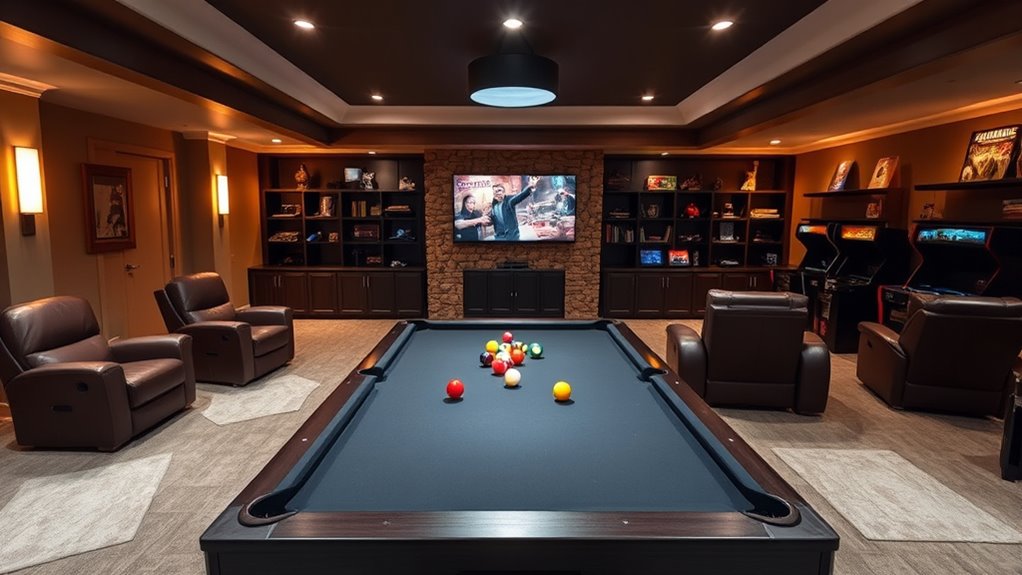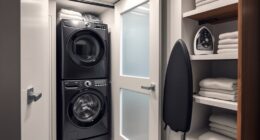When choosing between a game room or home theater, consider how you’ll use your basement most. Focus on planning flexible layouts, good soundproofing, and proper lighting for all activities. Think about structural needs and ventilation to guarantee comfort and safety. With the right equipment and design, you can create a versatile space for gaming, movies, or social gatherings. Keep exploring to discover how to maximize your basement’s full potential for fun and relaxation.
Key Takeaways
- Define primary use to guide design: gaming, movies, or social gatherings.
- Optimize layout with flexible furniture and designated zones for different activities.
- Prioritize soundproofing and lighting control to enhance audio-visual experiences.
- Ensure structural reinforcement and moisture control for durability and safety.
- Budget wisely by balancing equipment choices, DIY options, and phased upgrades.
Understanding the Purpose of Your Basement Space
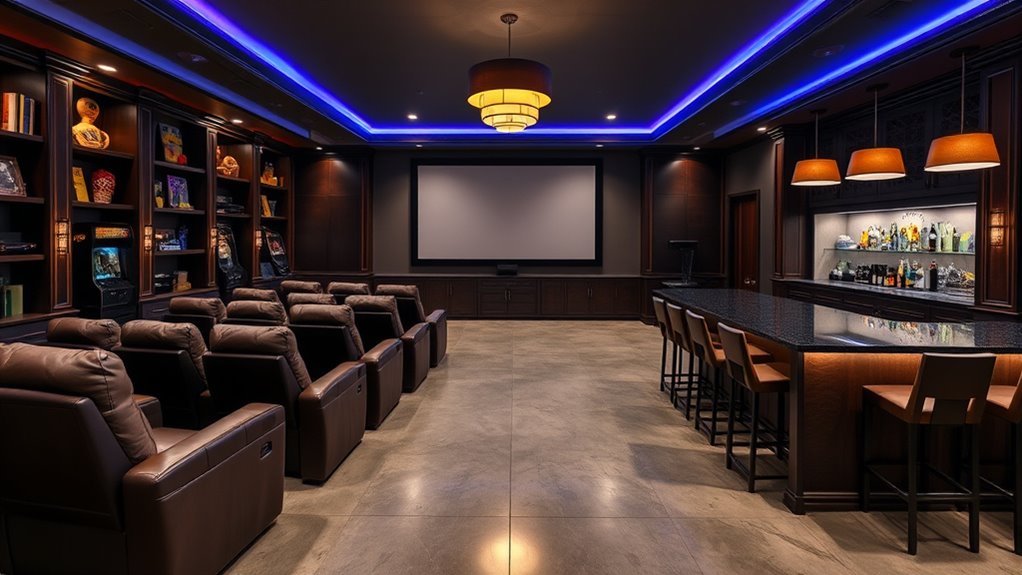
Have you ever thought about what you want to achieve with your basement space? Clarifying your purpose helps shape your design choices and maximizes functionality. If you plan to use it as a game room or home theater, consider how the space will support entertainment needs—ample seating, soundproofing, and lighting control are key. Think about the size of your basement; the average finished area in the U.S. is around 1,113 sq. ft., giving plenty of room for different setups. Remember, the layout and ceiling height influence how you use the space, whether for gaming, movies, or social gatherings. Defining your goals early ensures your basement becomes a versatile, enjoyable space tailored to your lifestyle and entertainment preferences. Home theater projectors can be a crucial element in creating an immersive viewing experience that complements your space. Basement sizes vary regionally, and understanding this can help you plan effectively.
Assessing Acoustic and Lighting Needs

To create the perfect game room or home theater, you need to carefully assess your acoustic and lighting requirements. Soundproofing techniques can help minimize noise transfer, while smart lighting controls ensure the right ambiance for movies or gaming. By managing ambient light and sound, you’ll enhance your space’s comfort and performance. Proper acoustical treatment also plays a crucial role in ensuring that sound is clear and evenly distributed, preventing echo and dead spots in low-ceiling rooms. Additionally, understanding the AI’s role in cybersecurity can inform you about potential vulnerabilities in your smart home systems, helping you implement better protection measures.
Soundproofing Techniques
Evaluating your acoustic and lighting needs is essential for creating an effective soundproofing plan that enhances your basement game room or home theater. Start by identifying noise sources and how sound travels within the space. Use fiberglass or mineral wool insulation between studs or joists to absorb sound and reduce noise transmission. Apply SONOpan panels on walls and ceilings to improve sound isolation, and incorporate resilient channels to decouple drywall from framing, especially for low-frequency sounds. Use ⅝” soundproof drywall for added mass. Seal all cracks, gaps, outlets, and ceiling penetrations with acoustic caulking or sealed boxes to prevent leaks. Combining multiple materials, sealing flanking paths, and addressing specific sound frequencies will optimize your soundproofing efforts, ensuring a quieter, more immersive environment. Proper planning can significantly improve the effectiveness of your soundproofing strategies and prevent costly reworks later on, especially as automation technologies become more prevalent in home entertainment setups.
Lighting Control Strategies
Understanding your acoustic and lighting needs is essential for designing a home theater or game room that offers the perfect viewing and gaming experience. Seamless integration of lighting with your projection system prevents disturbances like “cross talk,” ensuring clear visuals. Advanced systems, such as Lutron RTISS, eliminate interference, enabling multiple lighting modes—whether for seating, previews, or total darkness. Reliable, commercial-grade components reduce maintenance and increase longevity. Flexible controls allow you to set different moods for movies, games, or events. Incorporating ambient lighting options can further enhance the atmosphere and overall enjoyment of your space.
Ambient Light Management
Have you considered how ambient light influences both your visual and acoustic experience in your game room or home theater? Excessive light washes out images on TVs and projectors, reducing contrast and color saturation. Shiny screens reflect glare, making it hard to see clearly. Projectors, especially in brighter rooms, need near-total darkness or specialized screens like ALR to perform well. Window coverings such as blackout shades help control light leakage, but gaps can still compromise the environment. Combining high-lumen projectors with ALR screens offers better results in brighter spaces. Layered lighting—overhead, task, and accent—allows flexibility, while heavy curtains can also absorb sound. Managing ambient light ensures clear visuals and balanced acoustics, creating an immersive and comfortable entertainment space. Additionally, understanding room acoustics and how to optimize sound absorption can significantly enhance the overall experience.
Planning Layout and Flexibility for Activities
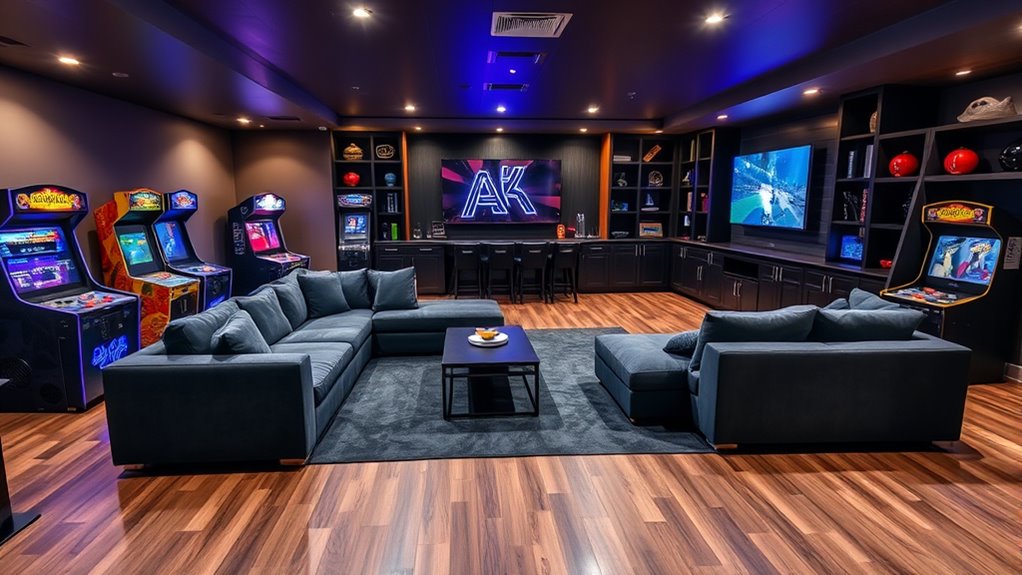
Planning the layout of your basement involves creating a versatile space that can adapt to various activities without sacrificing comfort or flow. Use open-concept designs for flexibility, and consider angled seating to maximize capacity and viewing angles. Multi-row stadium seating suits traditional theater setups with standard ceiling heights. Combining zones—like a theater, game area, or bar—optimizes space. Incorporate movable furniture, such as convertible seats and oversized sectionals, for changing needs. Strategically position entertainment zones, keeping pathways clear and traffic flowing smoothly. Use corners or dead spaces for storage or bars. Proper tech placement, like projectors and wiring, ensures unobstructed views and easy upgrades. Focus on adaptable furniture, zones, and technology to make your basement a multi-functional hub. Additionally, selecting flexibility features like modular furniture enhances the room’s adaptability for various activities.
Considering Structural and Renovation Requirements

Before starting your renovation, you need to evaluate any structural reinforcement requirements, like support posts or columns that could obstruct your layout. Proper ventilation and moisture control are essential to prevent damage and maintain comfort in your game room or theater. Addressing these factors early ensures your space remains functional, durable, and enjoyable. Additionally, understanding the importance of proper ventilation can help prevent issues such as mold growth and humidity problems that may compromise your equipment and overall comfort. Ensuring adequate air circulation is also vital for maintaining a healthy environment and protecting your investment.
Structural Reinforcement Needs
When converting a basement into a game room or home theater, guaranteeing the structural integrity of the space is essential. You may need foundation reinforcement methods like underpinning, which involves excavating beneath existing footings to pour new ones and rebuild walls for added stability and height. Alternatively, benching creates a lowered slab inside the perimeter, offering a quicker, cheaper solution but reducing usable space. Both methods should be performed by experienced contractors to avoid compromising safety. Reinforcing materials like high-quality concrete, rebar, welded-wire mesh, or fiber reinforcement help improve durability, especially if heavy equipment is involved. Additionally, evaluating existing slabs and adding steel beams or extra slab thickness ensures the floor can handle increased loads, protecting your investment and ensuring safety. Proper inspections and planning are crucial before initiating any structural modifications to prevent future issues.
Ventilation and Moisture Control
Ensuring proper ventilation and moisture control is essential when converting a basement into a game room or home theater, especially given the structural considerations involved. You should install inline fans, like AC Infinity models, for efficient airflow, and incorporate silencers to keep noise levels low during movie or game time. Strategic duct placement prevents drafts and hotspots, while fan speed controllers allow you to adjust noise and airflow as needed. Suspend fans and ducts with rope clip hangers or joist Saf-T-Bars for stability. To combat moisture, use dehumidifiers and apply vapor barriers on walls and ceilings. Seal openings with caulking or foam, and opt for double-layer drywall for added moisture resistance. Regular cleaning, filter replacement, and humidity monitoring keep the system effective and your space comfortable. Additionally, understanding the state tax implications for IRA withdrawals can help optimize your overall retirement planning and financial health.
Choosing Equipment and Entertainment Options

Choosing the right equipment and entertainment options is essential for creating an immersive home theater experience. Start with your visual display—select between TVs and projectors based on your room size and desired image quality. For sharp visuals, prioritize resolution, brightness, contrast, and color accuracy. Larger basements with space benefit from projection systems, while smaller or multi-use rooms suit TVs. Opt for 4K resolution as standard, with some considering 8K for future-proofing. Proper screen placement enhances viewing comfort and immersion. For audio, a surround sound system with speakers, subwoofer, and receiver delivers a rich experience. Formats like Dolby Atmos or DTS:X deepen immersion. Use media sources like Blu-ray, streaming devices, or media servers to access diverse content, ensuring seamless integration with your equipment setup. According to recent industry data, Apple leads the TWS market, holding a significant share and driving innovation in wireless audio devices. Additionally, incorporating AI-powered audio optimization can enhance sound quality by automatically adjusting speaker settings for the best listening experience.
Budgeting for Design and Customization
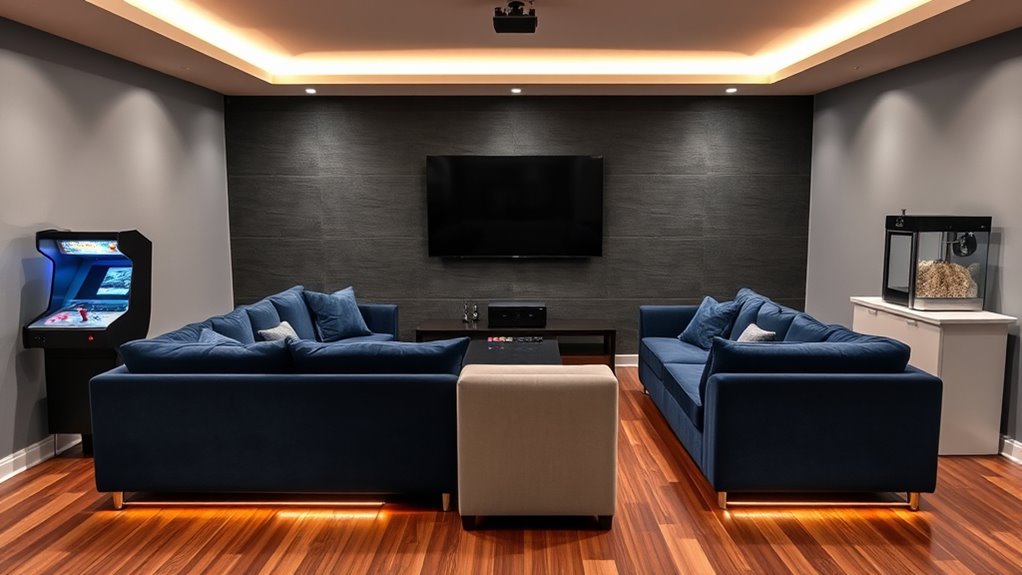
Budgeting for design and customization is a crucial step that influences the overall cost of your home theater project. Your expenses will include professional design services, acoustic treatments, screen placement, and custom features like risers and lighting. Keep in mind that customizing seating, décor, and ambiance can notably add to your budget. DIY options may cut costs but require technical skills to avoid costly mistakes. Equipment integration, such as wiring, soundproofing, and smart home controls, also impacts expenses. Labor costs can be substantial, especially for complex installations involving structural changes or specialized craftsmanship. To stay within budget, consider repurposing existing basement space, setting realistic goals, and prioritizing early design choices to prevent costly revisions later. Phased upgrades can help manage expenses over time. Additionally, understanding Bike maintenance and setup, such as proper gear shifting or tire inflation, can inform your planning process and help you avoid unnecessary expenses.
Addressing Ventilation and Comfort Concerns
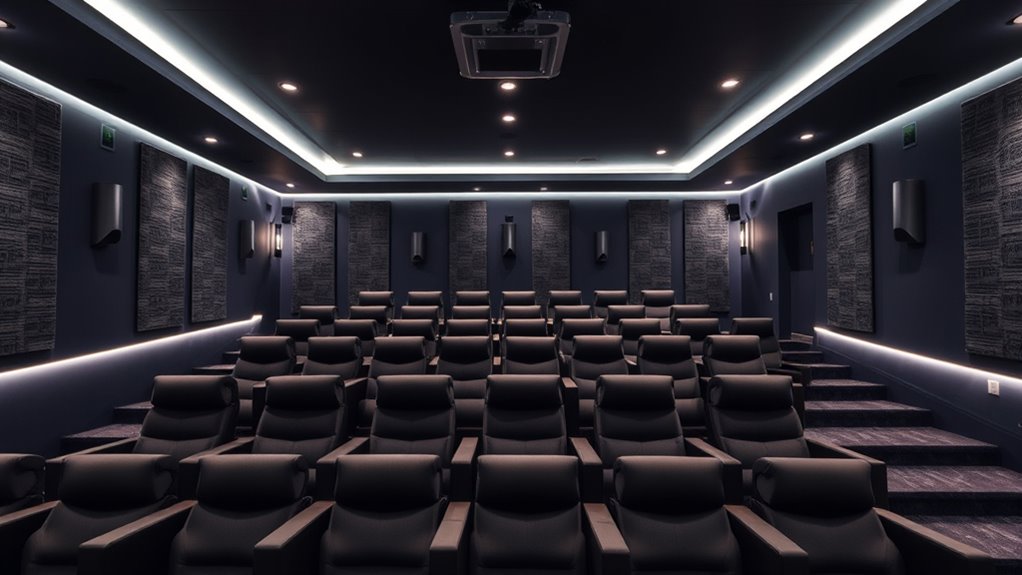
Addressing ventilation and comfort concerns is essential for creating a home theater that feels inviting and functions properly. Start by installing inline duct fans designed for basement theaters to ensure good air circulation and prevent stuffiness. Position vents carefully to avoid drafts or hotspots, especially around seating areas. Use silencers or noise-reducing ductwork to keep fan noise from disrupting sound quality. Incorporate automated vent systems that activate during use, maintaining fresh air without manual effort. Combine ventilation with humidity controls, like dehumidifiers, to prevent dampness and moisture damage. Vents should be placed for even air distribution and to avoid drafts, ensuring optimal airflow throughout the room. Regularly inspect and maintain equipment, suspending fans securely and choosing discreet, aesthetic vents that blend with your room.
Enhancing Value and Functionality of Your Recreation Area
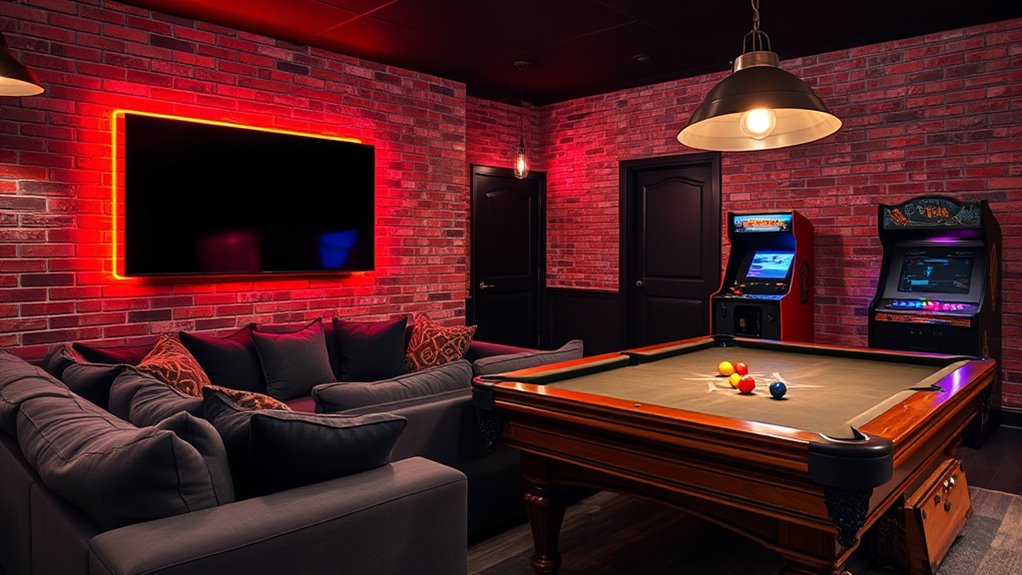
Enhancing the value and functionality of your recreation area involves strategic planning and thoughtful investment. The costs vary widely, typically around $20,000, depending on room size, finishes, equipment, and labor. Upgrades like technology, soundproofing, and custom features boost both appeal and usability, increasing your home’s resale value and making the space more attractive to buyers. Proper layout is vital; guarantee enough clearance around game tables and furniture to maintain comfort and flow. Incorporate versatile elements like multi-purpose zones—combining a bar, theater, and gaming area—to maximize space. Adding quality audio-visual equipment, ambient lighting, and durable fixtures enhances the experience and longevity of your space. Investing wisely in these features transforms your basement into a functional, valuable entertainment hub. Costs can also be influenced by regional labor and material prices, affecting the overall budget.
Frequently Asked Questions
How Can I Improve Soundproofing in My Basement for a Home Theater?
To improve soundproofing in your basement, start by sealing all gaps and cracks to prevent noise leaks. Add insulation like Owens Corning pink inside walls and ceilings, and consider installing a double wall system with an air gap for better sound absorption. Use acoustic panels strategically on walls and ceilings, and opt for sound-absorbing flooring like carpet tiles. These steps create a quieter, more immersive environment.
What Lighting Options Are Best for Versatile Game Room Setups?
Oh, lighting options? Because who doesn’t want their gaming den to look like a spaceship cockpit or a cozy cave? You should pick adjustable LEDs with dimming and color-changing features for maximum fun. Aim for 3000K-4000K for comfort, and add accent lights for style. Smart lights that sync with your game make it even better. Basically, make your space versatile, lively, and perfect for every gaming mood.
How Do I Balance Space for Both Gaming and Cinema Experiences?
You need to carefully balance your basement space to enjoy both gaming and cinema. Start by zoning areas with furniture or partial dividers, keeping large equipment like pool tables away from seating. Use flexible furniture for easy reconfiguration, and plan for soundproofing to prevent noise from spilling over. Select appropriately sized screens and ensure wiring supports both activities. With thoughtful layout and sound management, you’ll create an inviting space for all your entertainment needs.
What Are Cost-Effective Ways to Upgrade Basement Ventilation?
Think of your basement as a living lungs, needing fresh breath to stay vibrant. You can boost ventilation cheaply with reversible window fans, foundation vents, and regular vent cleaning. Portable fans and air purifiers help move and filter air effectively. For a more robust solution, consider natural ventilation for savings or mechanical systems for better control, but weigh the costs. Keeping airflow steady guarantees your space stays fresh and inviting.
How Can I Customize My Basement to Increase Home Value?
To increase your home’s value through basement customization, focus on creating functional, versatile spaces like guest suites, home offices, or gyms. Add modern finishes, include bathrooms or wet bars, and make sure your design complies with local codes. Improve energy efficiency with insulation, energy-efficient windows, and HVAC systems. These upgrades boost livability, appeal to buyers, and can lead to a higher resale price, making your basement a valuable asset.
Conclusion
By transforming your basement into a versatile entertainment space, you boost your home’s value and create lasting memories. Did you know that a well-designed basement can increase your home’s value by up to 20%? Whether you choose a game room or home theater, careful planning ensures you maximize the space’s potential. Focus on your needs, budget wisely, and don’t forget to prioritize comfort—your perfect entertainment haven is within reach.
